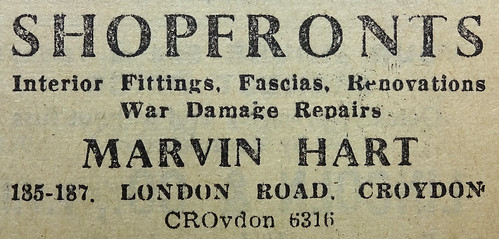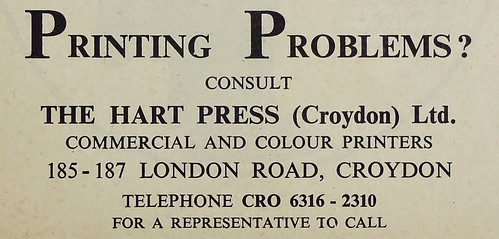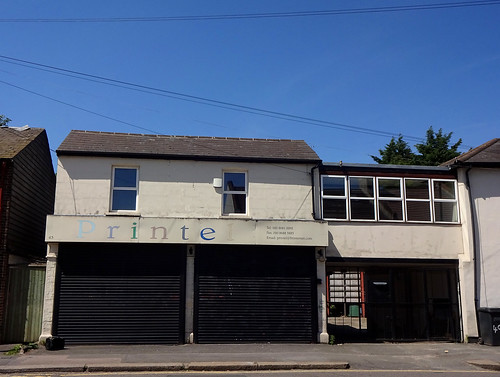Vistec House at 185 London Road, currently being converted into flats, was originally built as an office block. Its construction in the 1960s required the demolition of a pair of semi-detached houses which had stood there since the 1840s.
In the first article in this mini-series, I described the inhabitants of the left-hand house up to the point where it was taken over by shopfitting firm Marvin Hart Ltd, while in a second article I covered the right-hand house up to the same point. Here I discuss Marvin Hart Ltd (and its founder, Marvin Hart himself), the demolition of the houses, and the construction and later history of Vistec House.
1930s-1960s: Marvin Hart, shopfitters
Born in Bow at the turn of the century, Marvin Hart became a professional boxer as a teenager and continued in this career for around a decade.[1] An article in The Times describes one of his fights, at the National Sporting Club in Covent Garden on 5 October 1925:[2]
“The best fight of the evening, however, was between Marvin Hart, of Croydon, and Gunner J. Stephens, of the Royal Artillery. The former [...] is an aggressive and hard-hitting middle-weight [...who] had broken a couple of Stephens’s ribs when the two last met. [...] Hart, the shorter but stronger man, rushed and swung his blows with almost melodramatic fury, but himself twice had to take counts and twice, in addition, overbalanced himself and fell rather hurtfully onto the boards. [...] it was a severe but most sportsmanlike encounter, and Hart’s cheery acceptance of the decision against him was quite as pleasant in its way as Stephens’s pluck and steadiness under fire.”
![A black-and-white text-only advert headed “Petrol Thieves”, exhorting motorists to “Safeguard your meagre petrol ration by fitting the Eazifit Lock for petrol tank caps [...] Obtainable from Marvin Hart, 187, London Road, Croydon”.](/history/images/0185/marvin-hart-petrol-tank-lock-500px.jpg)
After retiring from boxing, Marvin turned to shopfitting. Marvin Hart Ltd was formed in January 1933, with Marvin as sole director, and had premises at 187 London Road by the end of the year. By early 1937 Marvin was also operating a colour printing company, Hart Press, from the same address.
Things did not go entirely smoothly; Marvin Hart Ltd was forced into liquidation, as was another company, Paramount Shopfitting & Construction, which had been formed to take over the first company.[3] Marvin himself was brought up before Croydon Bankruptcy Court in December 1940, as reported in the West Sussex Gazette:[4]
“His debts were £3,240 [£178,000 in 2018 prices] and assets nil. Debtor said that on retiring from the ring he became a shop-fitter, and later formed companies, on whose behalf he became an unlimited guarantor to a trust company for discounted bills of customers. Then he interested himself in a printing business, and afterwards opened shops at Ewell, Banstead, Selsdon, and Cliftonville, where the sale of flowers was combined with libraries. ‘I read and digested a book on how to run twopenny libraries,’ said debtor, ‘and thought it a splendid opportunity of becoming a millionaire, but lost money every week.’
“He patented a motor petrol tank lock, hoping to make money, but garages would not buy it. He went into a scrap-metal and motor-breaking business, but it lasted only a month. His speculations he admitted were very unfortunate, but would not agree with the Official Receiver that they were wild.”
Marvin was not put off by any of this. He continued to work as a shopfitter under his own name, and Hart Press continued in business too. By October 1946 he had expanded from 187 London Road to number 185 next door, hence occupying both halves of this century-old semi-detached pair.[5]


1950s: The threat of demolition
By the late 1950s, plans were being made to demolish 185 and 187 London Road and replace them with a new car showroom and offices for the Smith Auto Company, which at the time was located just down the road at number 145. Number 145 itself was built at around the same time as numbers 185–187, though unlike the latter had been extended substantially in the years since.
The Smith Auto Company’s planning application for “demolition of the existing building and the erection of motor showrooms and offices” was granted on 16 December 1957, but for some reason these plans were not put into place. Smith Autos remained at 145 London Road, and numbers 185–187 remained intact.[6]

1960s: Actual demolition
Although Marvin Hart seems to have given up the shopfitting business around the start of the 1960s — unsurprisingly, since he was in his own 60s at this point — Hart Press continued to operate from 185–187 London Road until 1963. However, the end of these buildings was now finally in sight.
On 18 May 1962, Croydon Council received a planning application for “[d]emolition of existing buildings and erection of office block with storage, garage accommodation and [caretaker’s] flat”. The application was granted, and by June 1964 Hart Press had moved to 43 Cross Road in East Croydon and the old semi-detached pair of houses had been replaced by a new office block: Vistec House.[7]
1960s–1980s: The Viscose Development Company
The impetus behind this project came from the Viscose Development Company, which had its roots in a pioneering technique created several decades earlier. Three industrial chemists — Charles Frederick Cross, Edward J Bevan, and Clayton Beadle — were working at the Jodrell Laboratories at Kew in the early 1890s when they discovered a way to extract soluble cellulose from cotton and wood. After patenting their invention in 1892, Charles and Edward set up a number of companies aimed at exploiting the practical uses of the process.[8]
One of these companies was the Viscose Spinning Syndicate, founded by Charles in partnership with yet another chemist, Charles Henry Stearn, who had developed a way of producing flexible fibres from the “viscous cellulose solution” — viscose — created by Charles’ extraction process.
Although the initial motivation for producing these fibres was for use in electric lamp filaments, they were soon adopted by the textiles industry, with viscose silk companies being formed in “most of the European countries” by the end of 1905. Viscose is still widely used in textiles of all kinds today.[9]
The Viscose Development Company followed a different path. Founded in 1902 as a merger of the Viscose Syndicate and the British Viscoid Company (both of which had been set up in the 1890s by Charles and Edward), it focused on non-fibre applications of viscose such as moulded materials and cellulose sponges. As technology developed, the company branched out into working with newer materials such as polythene and fibreglass.[10]
By the time it arrived on London Road, the Viscose Development Company already had a history of building its own premises, including “a new factory, with a floor area of 77,700 square feet” on “the foreshore near the South Dock, Swansea” in the late 1940s/early 1950s. Given that the Swansea factory, which employed around 350 workers, needed to discharge around “100,000 gallons of process water per day [...] into the sea”, it seems clear that no manufacturing was likely to take place at the new Croydon premises.[11]
![A black-and-white text-only advert headed “Representative” in large type, with below: “Spontex household cleaning products / based in the Reading area to cover [...] Oxfordshire, Berkshire, Hants., Wilts and Dorset, calling on grocery, hardware, motor and decorating outlets.” The address at the bottom is “Spontex, Consumer Products Division, Viscose Group Ltd, Vistec House, 185 London Road, Croydon”.](/history/images/0185/spontex-advert-500px.jpg)
The Viscose Development Company remained at Vistec House until the mid-1980s, joined along the way by associated companies Sponcel Ltd, which made sponges and sponge cloths; Viskase Ltd, which specialised in food casings such as sausage skins; the Viscose Group; and Viskraft Signs.
Viskase Ltd seems to have remained here the longest of these, but in any case all had departed by 1988.[12]
1990s–2000s: Bullen Consultants
Among the last companies to use Vistec House as office premises were Bullen Consultants Ltd and their sister company Bullen & Partners. Previously located across the road at numbers 188–190, Bullen opened a second office at Vistec House around 1990. They departed their other premises by the middle of the decade, but remained at Vistec House until around 2005–2006.[13]
2000s: Berkeley Solicitors
Shortly before Bullen left London Road, they were joined by Berkeley Solicitors, run by Manndred Ifeanyichukwu Adophy and John Eni-Uwubame. Based on the third floor of Vistec House, the firm offered a wide range of legal services: conveyancing; family and matrimonial; immigration; civil and commercial litigation and dispute resolution; wills, trust, and probate; criminal law; and corporate and commercial law.[14]
By March 2006, Berkeley Solicitors were advertising for “a Lawyer to work as a Chinese law consultant in our firm”, requiring candidates who were “qualified to practice as a Lawyer in China PRC”, with “a working knowledge of English and Mandarin”, and at least “2 years’ experience working in the UK”.[15] It seems they should also have specified a willingness to stay within the law, as a couple of years later their “consultant” Mr Lu was caught out by a Radio 5 Live investigation of immigration advisors.
Posing as a Chinese applicant for the newly-introduced highly-skilled migrant visa, the radio’s undercover reporter was advised by Mr Lu to “start up a consultancy company [...] pay in some money [...] and take some of the money out and there’ll be a cash flow”. This company could then be used to fake “extra income” to meet the necessary salary to qualify for the visa. The charge for all this would be “£1,500, as well as extra accountants’ fees to fake tax returns”. Although Mr Lu “later told the programme there had been a misunderstanding and he would never have advised the journalist to do anything illegal”, Berkeley Solicitors suspended him pending an investigation.[16]
Berkeley Solicitors remained at Vistec House only a short while; by November 2008, bankruptcy petitions had been filed against both partners, and by January 2010 both had been declared insolvent.[17]
2010s: Redevelopment
By the end of 2014, Vistec House had been vacant for around five years, and as with many other vacant office buildings in Croydon there was a general feeling that it could be better put to use as housing for the Borough’s growing population. Initial plans were to demolish it entirely and construct two new buildings with a communal garden in between, commercial space on the ground floor, and 55 flats above with 1–3 bedrooms each. Although Croydon Council were amenable to this, by mid-2015 the intention had changed: Vistec House would remain intact, but be converted to provide a total of 62 flats.[18]
Further amendments followed; a new planning application was lodged in July 2016 increasing the number of flats to 95, and another later the same year sought permission to build an additional “roof extension and nine storey rear extension to provide [...] one House in Multiple Occupation (‘Super’ HMO) totalling 90 letting rooms”. Both applications were granted, and by Autumn 2017 work was well under way.[19]
Despite this promising start, by mid-2018 the conversion of Vistec House had essentially come to a halt, with “a number of commercial reasons” preventing further progress. As of July 2019, only eight “residential units” are “complete and in an occupiable condition”, and work is projected to continue until at least early 2021.[20]
Thanks to: Jo Crosby of Solai Holdings; Kay Stuart-Tilley; the Planning Technical Support Team at Croydon Council; the staff, volunteers, and patrons at the Museum of Croydon; and my beta-readers bob and Kat. Monetary conversions performed using the Bank of England inflation calculator (prices < £100 given to the nearest penny, prices from £100 to < £100,000 to the nearest pound, prices from £100,000 to < £1 million to the nearest £1,000, prices from £1 million to < £100 million to the nearest £100,000, prices ≥ £100 million to the nearest million).
Footnotes and references
An article on page 3 of the 19 December 1940 West Sussex Gazette (“Boxing, books, and bouquets”) states that Marvin was 39 at the time of writing, and had been “a well-known South of England boxer, a professional for ten years to 1927”. Family historian Kay Stuart-Tilley provides more information about Marvin’s family background on Ancestry, including his birthplace, his birth date of 2 August 1901, and the fact that he was originally named Ernest Peterken. For proof of Marvin’s name change see, for example, a notice on page 2008 of the 4 April 1941 London Gazette relating to Marvin’s application for discharge from bankruptcy, which refers to him as “PETERKEN, Ernest (commonly known and described in the Receiving Order as Marvin Hart)”.
Our Marvin should not be confused with the American boxer Marvin Hart, who was born a quarter of a century earlier. It does however seem likely that the American was the inspiration for Marvin’s new name.
- “A new season at the N.S.C.”, The Times, 6 October 1925, page 12.
- The fact that Marvin took up shopfitting after retiring from boxing is from “Boxing, books, and bouquets”, as earlier. Ward’s 1934 directory lists M Hart at 187 London Road in 1934, and M Hart Ltd, shopfitters, in 1937 and 1939. All other information in this and the preceding paragraph is from an article on page 7 of the 9 June 1939 Croydon Advertiser (“Liquidation of Croydon Firm”).
- “Boxing, books, and bouquets”, as earlier.
- Date of expansion to number 185 is taken from an advert on page 11 of the 18 October 1946 Croydon Advertiser (reproduced here). London phone books continue to list Marvin Hart, shopfitter, and the Hart Press, at 187 and later also at 185 London Road throughout the 1940s and 1950s, up to and including 1963.
- Information and quotation regarding the demolition and replacement plans are taken from planning application ref 57/1528 (viewed on microfiche at Croydon Council offices). Another planning application for “Erection of Workshops” at “R/O [rear of] 185–187 London Road” (ref 57/1604) was also granted at the same time, but is marked “ABANDONED” on the property’s index card. See my article on 145 London Road for evidence on the Smith Auto Company remaining there.
- Quotation regarding the 1962 planning application (ref 62/737) is taken from the Croydon Council planning department index card for Vistec House; I have assumed that “Cateker’s flat” in the original should be “Caretaker’s flat”. Unfortunately I haven’t been able to view the records associated with this application, since someone else already had them out both times I tried to view them. Croydon phone books list Marvin Hart Shopfitters at 185 London Road and Hart Press (Croydon) Ltd, Colour Printers, at 187 London Road up to and including 1961; Hart Press at 185–187 London Road in 1962 and 1963; and Hart Press at 43 Cross Road from 1964 to 1987 inclusive. (Hart Press is also listed at 141 Croydon Road, Caterham, by 1985, and it continues to be listed here after the Cross Road listing disappears). Date of June 1964 for completion of Vistec House is taken from records of a planning application for a new pavement crossover providing “Vehicular access” to 185 London Road; the records include a handwritten note “Office block now on site named Vistec House”, and the crossover is marked as being completed as of 24 June 1964.
- Information in this section about the early beginnings of the Viscose Development Company is taken from two main sources: Edward Frankland Armstrong’s obituary of Charles Frederick Cross (Obituary Notices of Fellows of the Royal Society 1935, Vol 1, No 4, pages 459–464) and Regenerated Cellulose Fibres, edited by Calvin Woodings, Woodhead Publishing, 2001 (consulted via Google Books). The quotations in the following two paragraphs are from page 5 of Regenerated Cellulose Fibres and page 461 of Charles’ obituary, respectively.
- The idea of creating artificial fibres to replace natural materials such as silk had been around long before the discovery of viscose. Robert Hooke’s Micrographia, published by the Royal Society in 1664, speculates that “probably there might be a way found out, to make an artificial glutinous composition, much resembling, if not full as good, nay better, then that Excrement, or whatever other substance it be out of which, the Silk-worm wire-draws his clew. If such a composition were found, it were certainly an easie matter to find very quick ways of drawing it out into small wires for use.” (“Observation IV: Of fine waled Silk, or Taffety”, quoted from the Project Gutenberg edition). Regenerated Cellulose Fibres (see above) has a good overview of other attempts at artificial fibres that pre-date the creation of viscose. It also gives details of the rather difficult journey from Charles Stearn’s original discovery to the creation of a practical way to use viscose fibres in textiles, which I have skipped over here since it doesn’t directly relate to the Viscose Development Company.
- Information on later activities at the Viscose Development Company is taken from “History of Viscose” on the Viscose Closures website (accessed 15 June 2019).
- The first quotation is taken from an article on page 4 of the 10 March 1947 Western Mail (“Capital for new S. Wales factories”) and the second and third (and the figure of 350 workers) are from another article on page 2 of the 7 June 1946 Western Maril (“Artificial sponge works for Swansea”). Both of these articles pre-date the actual construction of the factory; the 1946 one covers a decision by the Swansea Corporation Highways Committee to approve the plans in principle, and the 1947 one discusses a new issue of shares to fund the construction. I don’t know when the factory was completed, but it was up and running by 1954, as a small article on page 5 of the 4 February 1954 Western Mail (“Fell into vat”) describes an accident there.
Croydon phone books list the Viscose Development Company at 185 London Road up to and including April 1984, and Viskase Ltd, Food Casing, up to and including 1987. Other companies are also listed along the way: Albany Life Assurance Co; Bovis Ltd, builders & contractors; Charles Delderfield Ltd; P F Bingham Ltd, paper & board merchants; Sponcel Ltd; Viscose Group; and Viskraft Signs. Sponcel, Viscose Group, and Viskraft Signs at least were associated with the Viscose Development Company, but I’m not sure about the others. Perhaps the Viscose Development Company found itself with more space than it needed, and leased out a floor or two to other businesses.
I don’t know where, if anywhere, the Viscose Development Company went after leaving Vistec House. It seems to have kept a presence in Swansea right up to the present day, where at the time of writing it operates under the name of Viscose Closures. More details of its history can be found on the Viscose Closures website.
- See my article on 188–190 London Road for evidence on movements by Bullen Consultants Ltd and Bullen & Partners. According to an article on pages 18–19 of the 16 December 2011 Croydon Advertiser (“Riot aid — but not where needed most”), the move from Vistec House was triggered by Bullen’s acquisition by Aecom in 2005.
- Berkeley Solicitor [sic] is listed at Vistec House in the 2005–6, 2006–7, and 2007–8 Croydon phone books. Names of the partners are taken from their bankruptcy notices on page 616 of the 15 January 2010 London Gazette and page 8647 of the 20 May 200 London Gazette, respectively. List of legal services is taken from the Internet Archive snapshot of Berkeley Solicitors’ website as of 7 February 2006, and the fact that they were on the third floor is taken from a snapshot of their “Contact Us” page as of the same date.
- Details and quotations taken from an advert in the Law section of the 7 March 2006 The Times.
- Details of the Radio 5 Live investigation, and all related quotations, are taken from “Advisers ‘told migrants to lie’”, Phil Kemp, BBC News website (accessed 19 June 2019). The article is described as being last updated on 12 April 2008, and makes reference to a programme that will be broadcast “on Sunday 13 April at 1900 BST on BBC Radio 5 Live”; 13 April 2008 was indeed a Sunday.
- Details of bankruptcies are taken from London Gazette personal insolvency notices, as above.
- Information on length of vacancy as of late 2014 is taken from the Statement of Community Involvement submitted as part of planning application ref 14/05302/P, which states on page 12 that “The site is a derelict 5 storey office block, that has been empty for 5 years.” My assertion re the general feeling of office buildings being better put to use as housing is my own personal recollection of online and offline discourse within Croydon at the time. Details of the demolition and reconstruction plans are also taken from the abovementioned planning application, which was submitted in December 2014 and granted in July 2015. The planning application for conversion to 62 flats was submitted in June 2015 and approved in August 2015 (ref 15/02834/GPDO).
- Planning applications ref 16/03542/GPDO and ref 16/05414/FUL, respectively. My statement about work being well under way by Autumn 2017 is from personal observation (see September 2017 photo reproduced here).
- A covering letter dated 11 July 2019 from planning and development consultants Shrimplin Brown to Croydon Council’s planning department states that “for a number of commercial reasons the works associated with the conversion of the offices did not progress far and indeed very little progress has been made over the past year in relation to the conversion. Eight of the residential units on the ground floor are complete and in an occupiable condition.” (included in planning application ref 19/03252/GPDO, which appears to be a renewal of prior approval for the conversion). Regarding the projected end date of the work, Jo Crosby of Solai Holdings told me in July 2019 that it would be “a good 18 months” until work had progressed to the point where they’d be able to let me visit and have a look at the interior (via email, 23 July 2019).


